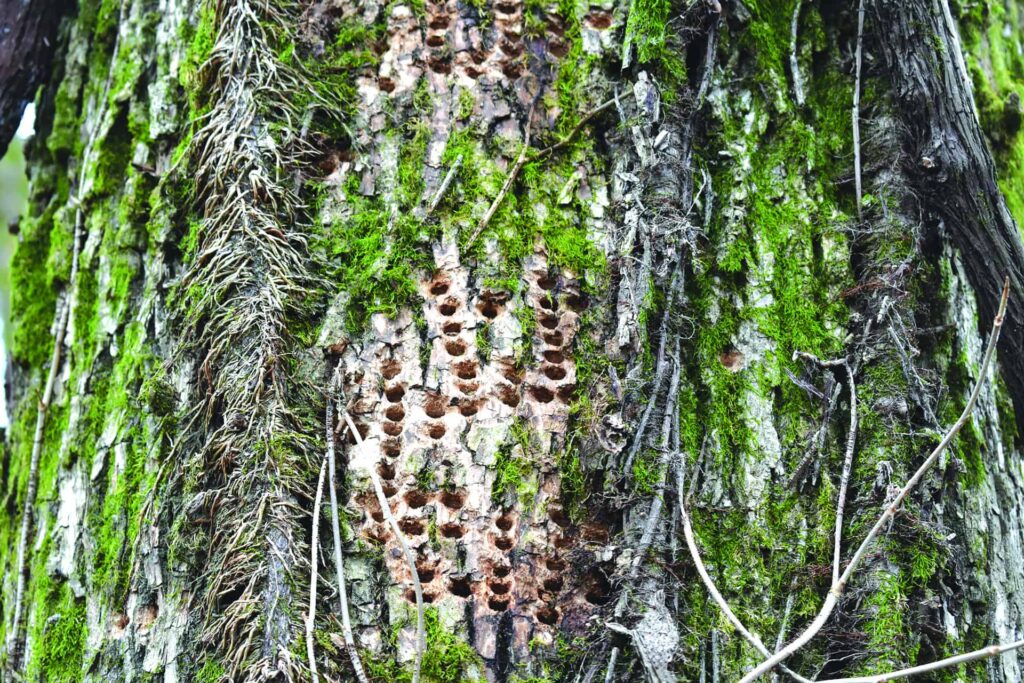story and photos by Tricia Dewey (she/her)
Turning one’s gaze to the landscape of Memphis in springtime, the greening panorama of trees is a lovely sight. Trees are everywhere– throughout the city’s neighborhoods, protected in swaths adjacent to the Wolf River and several other park areas, along the parkways, and in 17 designated arboreta around the city, including Elmwood Cemetery, Sea Isle Park, Rhodes College, and the Chucalissa Tree Trail.
Imagine the Fourth Bluff completely forested as it was originally. The entire Memphis area of the Mississippi Delta was covered with hardwood forest where herds of eastern elk, woodland bison, and red wolves roamed, which have all since been exterminated. There were ancient forests here while indigenous tribes maintained this area as a game forest, taking trees for fuel and building.
In the early 1800s and continuing after the founding of Memphis in 1819, through the early 1900s, land was cleared for agriculture and industrial uses, and subsequently for further development. The vast majority of trees in the Memphis area are secondary growth trees, meaning new growth after the original trees and vegetation have been removed. Overton Park is the only area in Memphis to have primary growth trees and has been designated Old Forest State Natural Area with 150 acres originally acquired for the public good in 1901. A recently downed tree there was aged from 1860; some of the trees exceed 200 years
old. For comparison most of the trees in Memphis neighborhoods were planted within 10 years of the age of the house.
The story of Memphis trees has many branches and layers (puns intended). It is complicated, and yet seems simple, just like the ecology of forests themselves, and Walt Whitman’s famous observation about a tree’s qualities, “How strong, vital, enduring!…It is, yet says nothing.” It is the story of a Tree City, and yet a city that was recently found to be at risk of declining forest canopy, and only in 2000 started to regulate clear- cutting for development.
After applying in 2012, Memphis was named a Tree City in 2014 by the Arbor Day Foundation. To achieve this designation Memphis enacted a tree care ordinance, hired a city forester, named an advisory Tree Board, holds yearly Arbor Day events, and spends a certain percentage of city funds on forestry each year.
Lucky for Memphis, many hardwood native trees are fast growing because of the local temperate climate. In addition, the abundant sunlight, good soil, and sufficient precipitation allow for a wide variety of native trees. On a short walk in the Lucius Burch Natural Area adjacent to Shelby Farms, Wes Hopper, certified arborist and Memphis Tree Board member, identified box elder/maple forest that transitioned into an ash/sycamore/maple forest with bald cypress, American chestnut, hornbeam, pawpaw, hickory, shumard oak, loblolly pine, and others mixed in.
The benefits of a healthy urban forest are many. A 2017 Nature Conservancy report documented the variety of ways trees improve the public health of cities. Not only are they aesthetically pleasing, urban forests have been shown to lower health care costs by encouraging outdoor engagement in exercise, connecting with the community, and reducing stress. The report discusses the economic benefits to improving urban forests such as increasing property value, improving stormwater management, protecting biodiversity, reducing air pollution, and reducing blight.



Incorporating these ideas, the 2015 Memphis Regional Canopy Action Plan (CAP), authored in part by the University of Memphis and Wolf River Conservancy, explained that the valuable urban and local community forest contributes to “environmental quality, public health, water supply, local economies, and aesthetic appeal.” The Plan noted that “Shelby County has more tree cover than other parts of the region but this cover is at risk….Suburban expansion is rapidly filling the gaps between cities.” CAP offered a multilevel action plan to reverse this decline that included providing baseline data to measure the changes to the canopy and prioritizing areas for tree planting in more than 200,000 potential acres for new urban tree canopy.
Mike Larrivee, cofounder of The Compost Fairy and general manager of Atlas Organics, says simply “we need more Memphis trees,” based on the loss of tree cover in Memphis in the last couple decades. “The Canopy Action Plan provided a significant amount of data. We had the perception that Memphis is a Tree City and left to its own devices it would be. We have lots of big trees compared to other parts of the country but our canopy is declining. The overall percentage of large trees in the city is dropping significantly and continuing to drop. And the distribution of trees continues to funnel into certain areas.” He says that “In deciding where to plant the trees, we were looking at areas of population with declining property value decline, and areas that were not more likely to be redeveloped in the near future.”
An initiative to plant four million trees in the next 10 to 15 years started in 2017 with the planting of 160 trees in the Medical District, but COVID-19 significantly upended continued efforts because it relied on volunteers to plant trees. “But,” Larrivee says, “we are continuing to move forward. We are partnering with the Wolf River Conservancy (WRC) and we have 1,000 trees that are ready to go in March.” This planting event was a coordinated effort with the Wolf RIver Conservancy, The Compost Fairy, and the West Tennessee Chapter of the Urban Forestry Council. According to Ryan Hall, WRC director of land conservation, over the past 16
years, WRC has planted more than 70,000 trees. This year he’s excited that WRC partnered with groups to work on tree planting: “WRC purchases seedlings and The Compost Fairy provides soil, literally from Memphian’s compost rejuvenated as soil, to help grow trees going into underserved neighborhoods to beautify and cut down on carbon for generations to come. It’s a win-win-win.” The Urban Forestry Council provides training and volunteers. Seventeen different tree species were potted for planting in the next year to ensure they are planting trees adaptive to a variety of conditions and that there is reasonable biodiversity. The event is part of the WRC Wolf River Restoration Series that aims to clean and beautify the Wolf River watershed throughout the year. https://wolfriver.org/annual-tree-planting
March is a big month for tree huggers in general–it is the traditional month for Arbor Day events. In addition to the WRC Tree Planting, the Memphis Botanic Gardens, along with Memphis City Beautiful and others, sponsored “Paint the Town Red,” giving away free native trees (with various red accents) for planting in yards. The tree story of Memphis continues with conversation, partnerships, and work to save trees. As Larrivee says, “Everybody has room for a tree. Everyone stands to benefit.”




